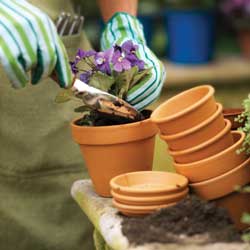
Low Vision and Blindness
Download a PDF of this fact sheet.

The ideas and suggestions in this section are specifically for creating gardens to be used by people with low vision or blindness. Remember, others should not work in a garden belonging to a person with low vision or blindness without specific instructions from that person. This is so that the gardener can keep a steady mental image of the garden's condition and needs. Doing work without letting the person know can greatly affect the garden because the gardener may not know changes were mde.
Garden Design
Orientation is very important for people with low vision or blindness. It helps them get around and know where they are while in the garden. Landmarks, like fountains, different textures, such as gravel and brick for walkways, and things that make sounds, like wind chimes, greatly help people orient themselves.
- It is easier for people to orient themselves on straight walkways. Curved walkways can make orientation difficult.
- Use a bush or large plant to mark changes in direction of walkways. Direction changes can also be marked with different textures used for walkway materials.
- Noise makers can mark different parts of the garden. Wind chimes and running water are good examples because they make distinct and easy-to-hear noises.
- Place plants with different fragrances in different parts of the garden. Fragrance helps people identify what section they are in.
Planting
The following are a few ideas to make planting easier.
- Use a board with holes drilled in it to help with spacing when planting seedlings or seeds. For smaller garden beds, the board can be sized to fit the whole bed.
- It may be easier to plant small seeds by using ¾ inch pieces of toilet paper. Lay seeds out on a plate or in a bowl. With a damp finger, pick up a seed or two. Wipe it off on the piece of toilet paper. Wad it up and drop the paper through the hole of the planting board and into the soil. The toilet paper will decompose quickly when it's covered with soil.
- Use a smaller flower pot to help guide and center planting in containers or flower pots. Put a layer of potting soil into the pot or container you are planting. Center a smaller pot on top of the soil. Fill the sides of the larger pot (the space between the smaller and larger pots) with soil, pressing the soil down a bit. Remove the small pot from the center, and place the seed or plant in the hole left by the smaller pot. Add enough soil to fill in the hole and hold the plant in place.
Tools

There are tools designed to assist people with low vision or blindness.
- One-handed shears makes pruning much easier. The gardener has one hand to feel the plant that is being pruned while the other hand works the shears.
- A wheelbarrow with two wheels, a resting leg, and one handle has many advantages. Many gardeners like to use this wheelbarrow because it has a more stable design than traditional wheelbarrows. Some people also attach a radio to the wheelbarrow so it is easier to locate.
Resources
Visit http://extension.oregonstate.edu for more details on accessible gardening for people with low vision and blindness. Adaptive Gardening Techniques for the Visually Impaired by Susan Foster and Clyde Duvall is an article that gives a detailed explanation on garden designs and gardening for people with low vision or blindness. This article can be found in the archives section under June 1992 of the above web address.
If you would like to talk to someone about accessible gardening, or would like a garden assessment done, call Green Thumbs, Healthy Joints at 800-841-8436.

